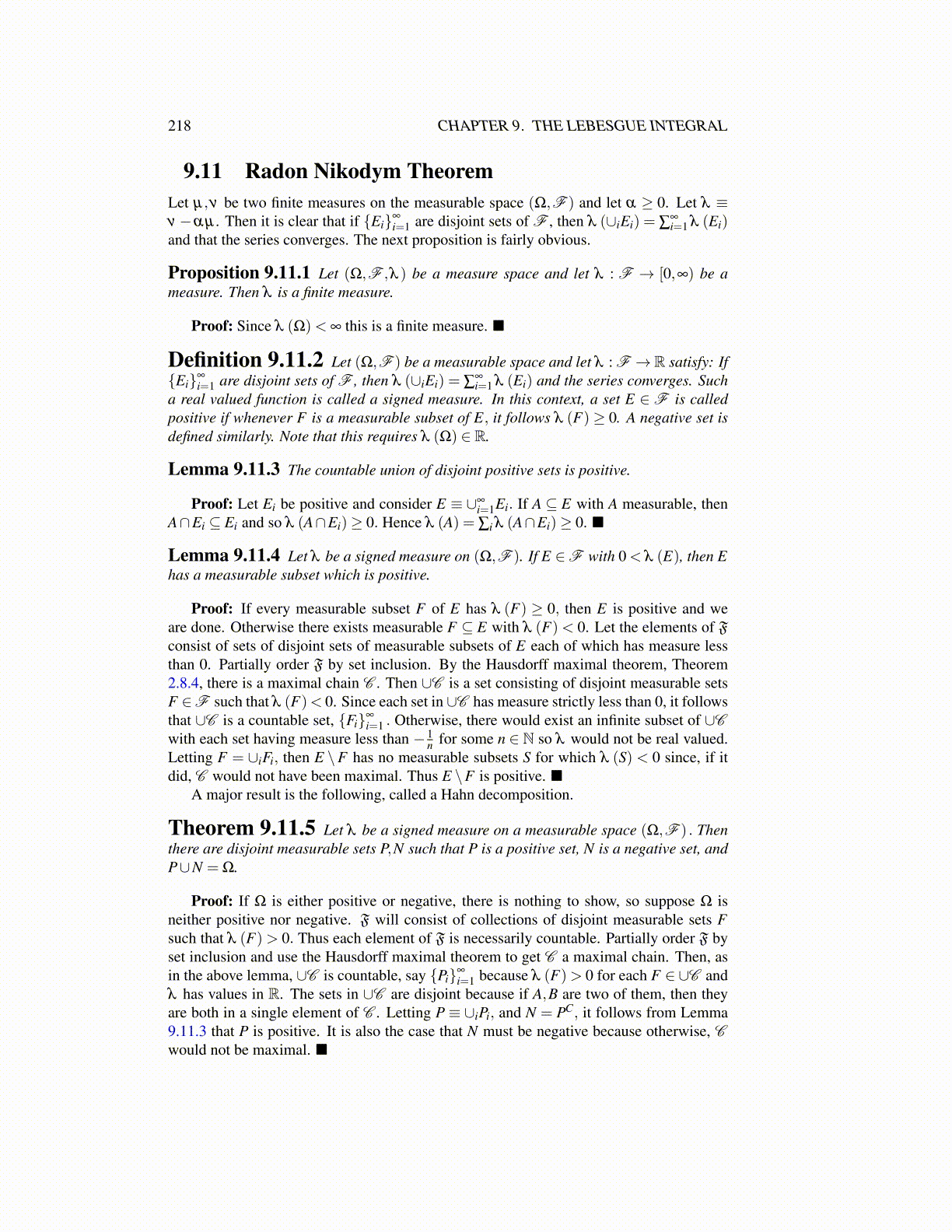
218 CHAPTER 9. THE LEBESGUE INTEGRAL
9.11 Radon Nikodym TheoremLet µ,ν be two finite measures on the measurable space (Ω,F ) and let α ≥ 0. Let λ ≡ν−αµ . Then it is clear that if {Ei}∞
i=1 are disjoint sets of F , then λ (∪iEi) = ∑∞i=1 λ (Ei)
and that the series converges. The next proposition is fairly obvious.
Proposition 9.11.1 Let (Ω,F ,λ ) be a measure space and let λ : F → [0,∞) be ameasure. Then λ is a finite measure.
Proof: Since λ (Ω)< ∞ this is a finite measure. ■
Definition 9.11.2 Let (Ω,F ) be a measurable space and let λ : F →R satisfy: If{Ei}∞
i=1 are disjoint sets of F , then λ (∪iEi) = ∑∞i=1 λ (Ei) and the series converges. Such
a real valued function is called a signed measure. In this context, a set E ∈F is calledpositive if whenever F is a measurable subset of E, it follows λ (F) ≥ 0. A negative set isdefined similarly. Note that this requires λ (Ω) ∈ R.
Lemma 9.11.3 The countable union of disjoint positive sets is positive.
Proof: Let Ei be positive and consider E ≡ ∪∞i=1Ei. If A ⊆ E with A measurable, then
A∩Ei ⊆ Ei and so λ (A∩Ei)≥ 0. Hence λ (A) = ∑i λ (A∩Ei)≥ 0. ■
Lemma 9.11.4 Let λ be a signed measure on (Ω,F ). If E ∈F with 0 < λ (E), then Ehas a measurable subset which is positive.
Proof: If every measurable subset F of E has λ (F) ≥ 0, then E is positive and weare done. Otherwise there exists measurable F ⊆ E with λ (F)< 0. Let the elements of Fconsist of sets of disjoint sets of measurable subsets of E each of which has measure lessthan 0. Partially order F by set inclusion. By the Hausdorff maximal theorem, Theorem2.8.4, there is a maximal chain C . Then ∪C is a set consisting of disjoint measurable setsF ∈F such that λ (F)< 0. Since each set in ∪C has measure strictly less than 0, it followsthat ∪C is a countable set, {Fi}∞
i=1 . Otherwise, there would exist an infinite subset of ∪Cwith each set having measure less than − 1
n for some n ∈ N so λ would not be real valued.Letting F = ∪iFi, then E \F has no measurable subsets S for which λ (S) < 0 since, if itdid, C would not have been maximal. Thus E \F is positive. ■
A major result is the following, called a Hahn decomposition.
Theorem 9.11.5 Let λ be a signed measure on a measurable space (Ω,F ) . Thenthere are disjoint measurable sets P,N such that P is a positive set, N is a negative set, andP∪N = Ω.
Proof: If Ω is either positive or negative, there is nothing to show, so suppose Ω isneither positive nor negative. F will consist of collections of disjoint measurable sets Fsuch that λ (F)> 0. Thus each element of F is necessarily countable. Partially order F byset inclusion and use the Hausdorff maximal theorem to get C a maximal chain. Then, asin the above lemma, ∪C is countable, say {Pi}∞
i=1 because λ (F)> 0 for each F ∈ ∪C andλ has values in R. The sets in ∪C are disjoint because if A,B are two of them, then theyare both in a single element of C . Letting P ≡ ∪iPi, and N = PC, it follows from Lemma9.11.3 that P is positive. It is also the case that N must be negative because otherwise, Cwould not be maximal. ■